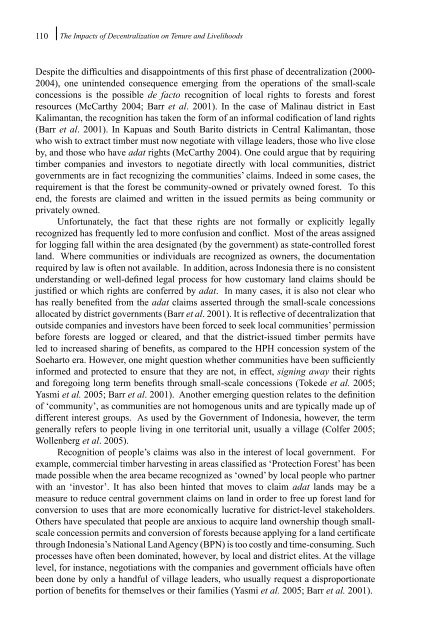Decentralization of Forest Administration in Indonesia, Implications ...
Decentralization of Forest Administration in Indonesia, Implications ...
Decentralization of Forest Administration in Indonesia, Implications ...
You also want an ePaper? Increase the reach of your titles
YUMPU automatically turns print PDFs into web optimized ePapers that Google loves.
110<br />
The Impacts <strong>of</strong> <strong>Decentralization</strong> on Tenure and Livelihoods<br />
Despite the difficulties and disappo<strong>in</strong>tments <strong>of</strong> this first phase <strong>of</strong> decentralization (2000-<br />
2004), one un<strong>in</strong>tended consequence emerg<strong>in</strong>g from the operations <strong>of</strong> the small-scale<br />
concessions is the possible de facto recognition <strong>of</strong> local rights to forests and forest<br />
resources (McCarthy 2004; Barr et al. 2001). In the case <strong>of</strong> Mal<strong>in</strong>au district <strong>in</strong> East<br />
Kalimantan, the recognition has taken the form <strong>of</strong> an <strong>in</strong>formal codification <strong>of</strong> land rights<br />
(Barr et al. 2001). In Kapuas and South Barito districts <strong>in</strong> Central Kalimantan, those<br />
who wish to extract timber must now negotiate with village leaders, those who live close<br />
by, and those who have adat rights (McCarthy 2004). One could argue that by requir<strong>in</strong>g<br />
timber companies and <strong>in</strong>vestors to negotiate directly with local communities, district<br />
governments are <strong>in</strong> fact recogniz<strong>in</strong>g the communities’ claims. Indeed <strong>in</strong> some cases, the<br />
requirement is that the forest be community-owned or privately owned forest. To this<br />
end, the forests are claimed and written <strong>in</strong> the issued permits as be<strong>in</strong>g community or<br />
privately owned.<br />
Unfortunately, the fact that these rights are not formally or explicitly legally<br />
recognized has frequently led to more confusion and conflict. Most <strong>of</strong> the areas assigned<br />
for logg<strong>in</strong>g fall with<strong>in</strong> the area designated (by the government) as state-controlled forest<br />
land. Where communities or <strong>in</strong>dividuals are recognized as owners, the documentation<br />
required by law is <strong>of</strong>ten not available. In addition, across <strong>Indonesia</strong> there is no consistent<br />
understand<strong>in</strong>g or well-def<strong>in</strong>ed legal process for how customary land claims should be<br />
justified or which rights are conferred by adat. In many cases, it is also not clear who<br />
has really benefited from the adat claims asserted through the small-scale concessions<br />
allocated by district governments (Barr et al. 2001). It is reflective <strong>of</strong> decentralization that<br />
outside companies and <strong>in</strong>vestors have been forced to seek local communities’ permission<br />
before forests are logged or cleared, and that the district-issued timber permits have<br />
led to <strong>in</strong>creased shar<strong>in</strong>g <strong>of</strong> benefits, as compared to the HPH concession system <strong>of</strong> the<br />
Soeharto era. However, one might question whether communities have been sufficiently<br />
<strong>in</strong>formed and protected to ensure that they are not, <strong>in</strong> effect, sign<strong>in</strong>g away their rights<br />
and forego<strong>in</strong>g long term benefits through small-scale concessions (Tokede et al. 2005;<br />
Yasmi et al. 2005; Barr et al. 2001). Another emerg<strong>in</strong>g question relates to the def<strong>in</strong>ition<br />
<strong>of</strong> ‘community’, as communities are not homogenous units and are typically made up <strong>of</strong><br />
different <strong>in</strong>terest groups. As used by the Government <strong>of</strong> <strong>Indonesia</strong>, however, the term<br />
generally refers to people liv<strong>in</strong>g <strong>in</strong> one territorial unit, usually a village (Colfer 2005;<br />
Wollenberg et al. 2005).<br />
Recognition <strong>of</strong> people’s claims was also <strong>in</strong> the <strong>in</strong>terest <strong>of</strong> local government. For<br />
example, commercial timber harvest<strong>in</strong>g <strong>in</strong> areas classified as ‘Protection <strong>Forest</strong>’ has been<br />
made possible when the area became recognized as ‘owned’ by local people who partner<br />
with an ‘<strong>in</strong>vestor’. It has also been h<strong>in</strong>ted that moves to claim adat lands may be a<br />
measure to reduce central government claims on land <strong>in</strong> order to free up forest land for<br />
conversion to uses that are more economically lucrative for district-level stakeholders.<br />
Others have speculated that people are anxious to acquire land ownership though smallscale<br />
concession permits and conversion <strong>of</strong> forests because apply<strong>in</strong>g for a land certificate<br />
through <strong>Indonesia</strong>’s National Land Agency (BPN) is too costly and time-consum<strong>in</strong>g. Such<br />
processes have <strong>of</strong>ten been dom<strong>in</strong>ated, however, by local and district elites. At the village<br />
level, for <strong>in</strong>stance, negotiations with the companies and government <strong>of</strong>ficials have <strong>of</strong>ten<br />
been done by only a handful <strong>of</strong> village leaders, who usually request a disproportionate<br />
portion <strong>of</strong> benefits for themselves or their families (Yasmi et al. 2005; Barr et al. 2001).

















